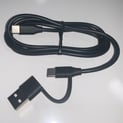How to connect Duet 3 to the USB-C port on an iPhone 15 or later
iPhones with the USB-C port do not provide as much power as iPad's, requiring the use of an external USB-C power supply.

Here are the most reliable connection steps:
- Connect an external USB-C power supply to one of the Duet 3's ports
- Wait for one of the lights on the Duet 3's top panel to illuminate
- Connect a USB-C to USB-A cable to the remaining Duet 3 port. The cable that came in the box with Duet 3 will work for this purpose

- Connect the USB-A cable into a second USB-A to USB-C adapter.
This Apple adapter is an example:
- Connect the USB-C adapter into your iPhone
- Open the Apogee Control 2 iOS app and your Duet 3 should be recognized
Here is a second method that does not require the use of additional adapters:
- Connect an external USB-C power supply to the Duet 3
- Immediately plug in a second USB-C cable between duet 3 and your iphone. If you plug it in too soon or too late, the iPhone won't recognize the Duet 3.